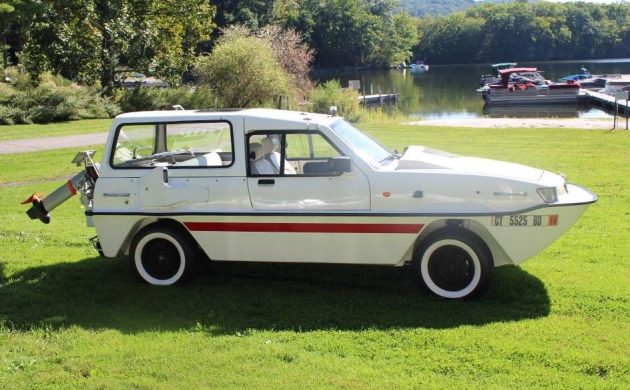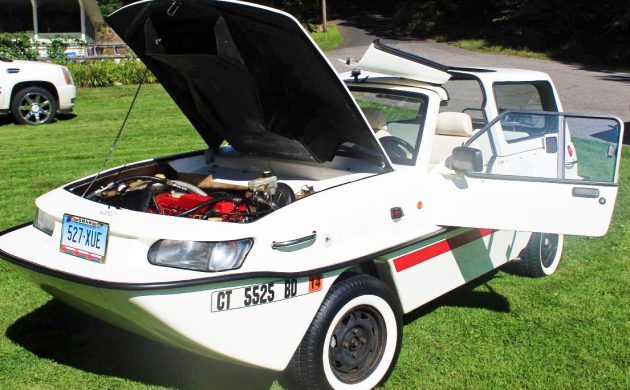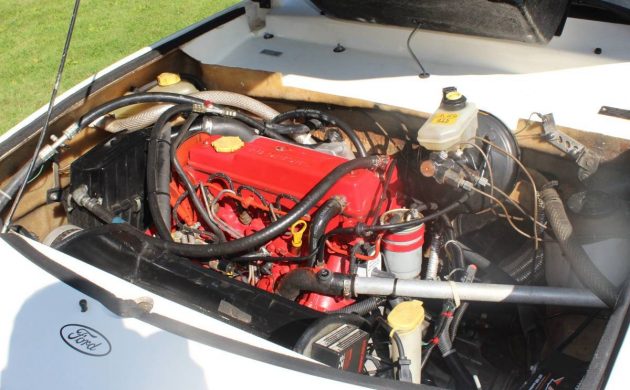Based in England, Dutton Cars Ltd. has been around for over 50 years and began by specializing in the manufacture of kit cars in 1969. In 1989 Dutton’s founder, Tim Dutton-Woolley, decided to take the company in an entirely new direction and switched from making kit cars to amphibious cars, a venture that has been quite successful over the past 30 years. Have you ever seen a Dutton? I searched the Barn Finds archives and was shocked to find that only one Dutton has been written about in the past on this site, and that was a post about a Melos kit car Josh featured way back in 2014. This extremely rare amphibious 1992 Dutton Mariner is for sale in Sherman, Connecticut. It’s listed here on Craigslist with an asking price of $39,000.
The Dutton Cars Ltd. website lists four amphibious models produced by the company since 1989: the Mariner (until 2000), the Commander (until 2006), and the current Surf and Reef models. With a total of only about 260 amphibious cars produced since 1989, there obviously aren’t very many Mariners in existence. What exactly is a Mariner and how was it built, you ask? Believe it or not, it started out as a Ford Fiesta!
Interviews with Tim Dutton-Woolley posted online reveal he can be a bit sensitive to his amphibious cars being compared to the successful and infamous Amphicar Model 770. Dutton-Woolley is often quick to point out just how short-lived production of the Model 770 was (1960-1965). The main difference between the Amphicar and a Dutton amphibious is in the materials used to build them. The Mariner was constructed using a one-piece glass-reinforced plastic hull, whereas Amphicars were built from automotive-grade steel which corroded very quickly after being dunked in water.
This Mariner is powered by a 4-cylinder 1.8 liter Ford diesel engine. The seller reports the boat-car features a manual transmission but doesn’t specify if it’s a 4 or a 5-speed. Once in the water, it’s propelled by a twin jet-propulsion system and is also outfitted with an electric trolling motor. With only 1,642 original miles it’s no wonder this Mariner is in such immaculate condition. Is the $39K asking price too steep? For reference, there really isn’t much to compare it to other than this 1990 Mariner, the very first one produced, that sold for $24,000 last year. It should be noted that, among other things, the ’90 Mariner was in need of repairs and had racked-up almost 31,000 miles when it was sold. Dutton Cars Ltd. claims that with its amphibious cars “no beach is out of reach.” What do you think of this oddball? Would it be practical to use? Simply a novelty? Or is it a rare car (or boat) collector’s dream come true?





It looks way better and safer than the Amphicars. A couple of bow bunnies and away you go!
Good luck getting out in a hurry, with that enclosed drivers compartment, it’s a crapshoot if it goes down.
Steve R
This would make a great addition to:
https://rvshare.com/blog/terra-wind-boat/
You could go & get your groceries and not lose your camping space.
Just do not know where the firepit would be.
I was a Merchant Marine for over 18 years. I kinda want this!
1992 Boston Whaler, $6500.
+
1992 Ford Escort, $2500.
I’m not seeing $40k of value here….
You forgot the $20 worth of duct tape to make the boat & car into a boatcar.
A Boston Whaler can’t take you through the McDonald’s drive through. Add $20k right there.
Beat bridge traffic at rush hour!
1,642 original miles, “Salvage Title”, $39,000, why…
Forgot to put in the drain plug once.
I have owned an original 1962 Amphicar for over twenty years. I also did all the service on the 1990 Dutton Marine that was sold for $24K last year. I can tell you from actual experience and not from theory, that the original Amphicars was exponentially better than the more recent Dutton produces thirty years later. The Dutton was superior in concept with its impeller propulsion design, front engine and glas-fiber body shell. The actual execution however was extremely inferior. The weight balance is wrong and the Dutton takes a long time to “plane” on the water.
Although the original steel Amphicar did rust if exposed to salt water, if only subjected to fresh water, it proved surprisingly durable and even when it did rusty Street got out fifty years, damage was usually limited to rear wheel arches which could be repaired with relatively simple Panel replacement. The Dutton was cobbled together with many improvised accommodations to electrical components and hydraulic components for the jet drive system.
Now if it’s sea worthy enough for the Puget Sound then I’ll have an answer for our often over crowded ferry system! No more room on the Port Townsend run, no problem honey, and I’ll pull a crab pot on the way home for dinner.
I can see you going over your head here!! Better strap on a life jacket before bidding starts!!! Just don’t go overboard!!!
How does the drivetrain and brakes do after being wet
There are no pictures of it in the water. Not a good sign. I’m thinkin’ there’s a reason for that.
Just Fishing here!
Wonder if the back opens/maybe a take off Carson kind of’ thing?
I have owned both a 1990 Dutton Mariner (Seriel #1001, the first one produced and referenced in this article), and a 1962 Amphicar.
While the Dutton is an incredible creation and really quite remarkable for how it is constructed and how it performs, my preference is the original Amphicar, by far.
Yes, the steel body can rust terribly if the car was exposed to salt water, but contrary to this write up, if limited to fresh water use, rust is usually confined to relatively simple repair of the lower rear panels behind the rear wheels every decade or so, which is a very manageable job. And contrary to this article, the steel is much thicker (and heavier) than “conventional automotive grade steel”.
The Amphicar is considerably faster on the water than the Dutton, and although the jet drives make more sense on paper, the execution on the Dutton is not that great. I much prefer the conventional propellers on the original Amphicar, which was designed and built almost three decades earlier! Surprisingly, my Amphicar also climbed in and out of the water with much more ease than the Dutton, probably because of the tall profile narrow tyres.
The Dutton is fun and can be purchased for much less money (even at this ambitious price) that a really nice Amphicar, but from someone who has owned both cars, I would spend a whole lot more for an original Amphicar.
I loved, and would choose to take my Amphicar on the road and on the water for my own personal driving and boating pleasure, whereas I would only fire up the Dutton if someone asked for a ride in it.
It was not pleasant to climb in or out of, and it was not fun to drive, and tediously slow on the water. Finally, while the Amphicar was aesthetically pleasing to look at, especially in the 1960’s, this thing looks like a duck out of water.
I can tell you that I sold the Dutton after less than a year of use, while I still own my Amphicar after fifteen years of ownership!
Just my opinion. Your mileage and enjoyment may differ!
That was a fascinating comment Charles. I doubt many of us have even seen both cars, let alone owned both of them.
Curious why the dual jet drives on the Dutton dont work as well as they should? Whats the flaw?
I’m not eactly sure what the flaw is, but I suspect that because the jet drives are driven by a fluid pump instead of a mechanical drive, there is some loss of efficiency.
It also may be related to the shape and weight of pushing that hull through the water, and how it planes on the water. I am not sure, but I know that the Dutton was slower, and although actual knots may be incremental (7 knots for the Amphicar and 6 knots for the Dutton if I recall correctly), it feels a whole lot slower on the water.
In fairness, Dutton may have improved that since our first 1990 version, but I doubt that he would have absorbed the cost of redesigning the jet drive system.
However, ANY car that can be driven into the water is incredibly cool, and I am not discouraging anyone from buying this. I am only challenging the assertion by Dutton, and repeated in this article, that the Dutton is a superior execution of the idea. I am only suggesting that IF you can afford the original Amphicar, it is a better choice for an amphibious vehicle.
lets take a suicide swim.
No
Ist das Auto noch zu verkaufen
Is the car still for sale?
Please contact me
[email protected]
I wanted a Dutton until I saw how slow it is.
Dutton and Amphicar both did Channel Crossings. When one Amphicar’s bilge pump plugged the other one towed it to France. The Amphicars were so much faster even with one being towed! The 92 Dutton is much slower than 6 knots. It is maximally 4,2 mph. The Amphicar is 12 kph until you ex change its motor for a Triumph Spitfire 1300 and then it goes 14 kph. I owned 3 Amphicars.